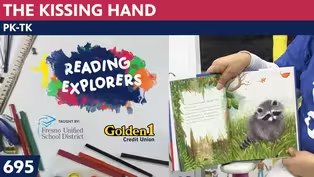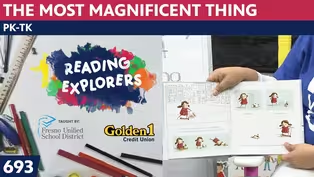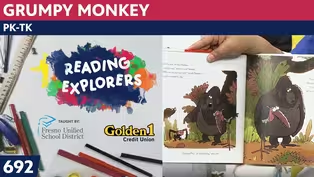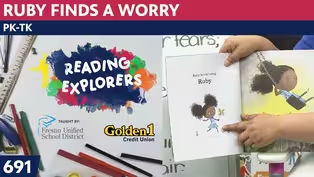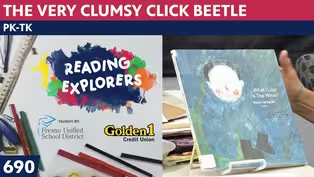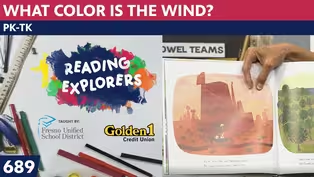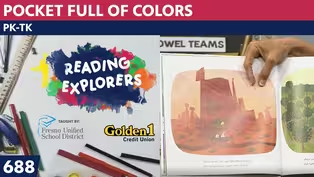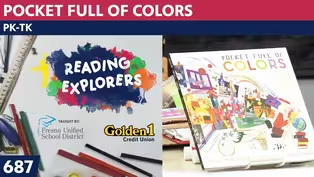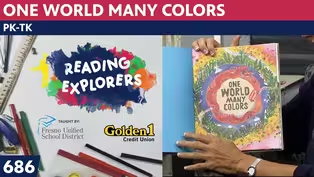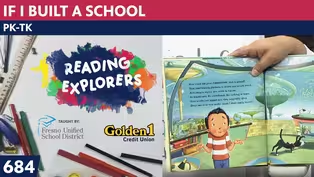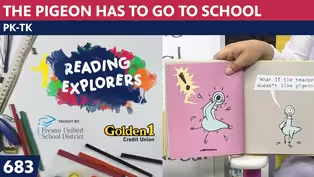
TK-342: Pablo Picasso
Season 3 Episode 228 | 14m 13sVideo has Closed Captions
Join Mrs. Readwright at Camp Discovery!
Transitional Kindergarten teacher, Mrs. Readwright, welcomes students back to Camp Discovery, a fun learning space packed with reading adventures & fun games!
Problems playing video? | Closed Captioning Feedback
Problems playing video? | Closed Captioning Feedback
Reading Explorers is a local public television program presented by Valley PBS

TK-342: Pablo Picasso
Season 3 Episode 228 | 14m 13sVideo has Closed Captions
Transitional Kindergarten teacher, Mrs. Readwright, welcomes students back to Camp Discovery, a fun learning space packed with reading adventures & fun games!
Problems playing video? | Closed Captioning Feedback
How to Watch Reading Explorers
Reading Explorers is available to stream on pbs.org and the free PBS App, available on iPhone, Apple TV, Android TV, Android smartphones, Amazon Fire TV, Amazon Fire Tablet, Roku, Samsung Smart TV, and Vizio.
Providing Support for PBS.org
Learn Moreabout PBS online sponsorshipMore from This Collection
Valley PBS and Fresno Unified School District have partnered with Golden 1 Credit Union to create Reading Explorers Lessons for grades Pre-Kindergarten through Third grade. The daily lessons will be taught by Fresno Unified School District teachers and are created to help students practice their reading skills and reinforce lessons during distance learning.
Video has Closed Captions
Valley PBS presents Reading Explorers Lessons for Pre-Kindergarten and TK. (26m 27s)
PK-TK-693-The Most Magnificent Thing
Video has Closed Captions
Valley PBS presents Reading Explorers Lessons for Pre-Kindergarten and TK. (26m 26s)
Video has Closed Captions
Valley PBS presents Reading Explorers Lessons for Pre-Kindergarten and TK. (26m 28s)
Video has Closed Captions
Valley PBS presents Reading Explorers Lessons for Pre-Kindergarten and TK. (26m 28s)
PK-TK-690: The Very Clumsy Click Beetle
Video has Closed Captions
Valley PBS presents Reading Explorers Lessons for Pre-Kindergarten and TK. (26m 22s)
PK-TK-689: What Color is the Wind?
Video has Closed Captions
Valley PBS presents Reading Explorers Lessons for Pre-Kindergarten and TK. (26m 21s)
PK-TK-688: Pocket Full of Colors
Video has Closed Captions
Valley PBS presents Reading Explorers Lessons for Pre-Kindergarten and TK. (25m 58s)
PK-TK-687: Dancing Through Fields of Colors
Video has Closed Captions
Valley PBS presents Reading Explorers Lessons for Pre-Kindergarten and TK. (26m 20s)
PK-TK-686: One World Many Colors
Video has Closed Captions
Valley PBS presents Reading Explorers Lessons for Pre-Kindergarten and TK. (27m 13s)
PK-TK-685: School is Wherever I am
Video has Closed Captions
Valley PBS presents Reading Explorers Lessons for Pre-Kindergarten and TK. (26m 32s)
PK-TK-684: If I Built a School
Video has Closed Captions
Valley PBS presents Reading Explorers Lessons for Pre-Kindergarten and TK. (26m 21s)
PK-TK-683: The Pigeon Has to Go to School
Video has Closed Captions
Valley PBS presents Reading Explorers Lessons for Pre-Kindergarten and TK. (26m 22s)
Providing Support for PBS.org
Learn Moreabout PBS online sponsorship(guitar strumming music) ♪ Good morning to a brand new day ♪ ♪ Time to learn and games you play ♪ ♪ Learning things is so much fun ♪ ♪ Learning is good for everyone ♪ (guitar strumming music) (cheerful music) - Hello, Early Learners, welcome back to the art room.
It's me, Mrs. Readwright.
Let's start our day with our hello song.
♪ Hello ♪ ♪ Nice to see you, everyone ♪ ♪ Hello ♪ ♪ Nice to see you, everyone ♪ ♪ Hello to you, hello to you ♪ ♪ Hello to you, hello to me ♪ ♪ Hello ♪ ♪ Nice to see you, everyone ♪ Boys and girls, you know what we're doing these days, it's the "ABC's Of Art" and today is the letter L. The letter L for lobster and we're meeting Pablo Picasso.
I don't know why I say meeting him, we did a nutcracker in the style of Pablo Picasso, we did a snowman in the style of Pablo Picasso and today we're doing a print that I had not really studied before when I was in art school and I thought it was interesting and kind of a funny story because usually cats will try and go after things that move.
Well, in this picture Pablo Picasso made this lobster going after the cat and the cat has its back up and I'm just making the lobster today but if you want to add the cat to it to be inspired by Pablo Picasso, the whole thing, then you can do that but I'm going to do the song about the "ABC's Of Art".
Ready?
♪ A B, C, D, E of art ♪ ♪ That's the way that we will start ♪ ♪ K is for kitchen ♪ ♪ Lobster starts with an L ♪ ♪ M is for mother we can tell ♪ ♪ N is for night ♪ ♪ Ocean starts with O ♪ ♪ Art and the alphabet ♪ ♪ Here we go ♪ (hands shuffling) All right, let's take a look at the art.
Let me turned myself sideways.
We know that Pablo Picasso was a Spanish artist and he started out painting and they even, he did so many kinds of art, he was kind of an experimental artist.
When he saw something he thought he'd give that a try, he'd give something else to try and at first he had his blue period where all his pictures were painted with shades of blue then he went into his rose period where things were colored with pinks and rose colored things and, you know, he's best known for his Cubist art where things are broken up and kind of put back together in a funny way.
So this lobster is lots of geometrical shapes and when we draw it we're going to make this shape and then add its head, it's long antenna, it's pincher claws and its other legs and it's fanned out tail and we're going to use different colors of blue and then when it dries I'm going to outline it with my permanent pen but if you want to outline yours with a black pen or a black paint later, that would work but you just have to wait for your paint to dry or it will mix together and it'll all be muddy.
and if you like muddy paints, that's your thing but I'm just saying I'm keeping my blues bright and beautiful so it kind of reminds me of the ocean.
Then, like I said, you can make the cat.
Look, he even painted some white teeth on it and look how scared that eye is and its claws are out, probably to say, "Get out of here, lobster!"
So, let's see what the rhyme is for the lobster.
"Picasso's Cubist lobster has scared this cat.
If I saw those pincher claws I would scat!"
(hands clapping) and scat means get out of here then the two rhymes are "cat" and "scat".
If you want to do this with me, put your hands out and we say, "Cat, scat.
They both say at."
(hands clapping) That's how we remember rhymes, if they both end with the same vowel sound, ending sound, those are rhyming ones.
Cat, at, at.
Scat, at, at.
Yep, they're in the same family.
Alrighty.
So, we know, and the other thing about Pablo Picasso, you know I told you, he's always dressed in a little striped shirt.
I just bought a puppet of him yesterday and one fits on my finger and another one's on a card and if I pull it up and I'd say, "Who is it?"
and they'd say, "Pablo Picasso cause he's wearing the striped shirt."
All right, let me set these things aside.
I even brought a little outline of a lobster so we'd have something to kind of look at.
I'm gonna put this on top of my construction paper box and get my table up.
Get up here, table.
Alrighty, and pick up my things.
Now I do like to ask you how you think I'm going to put my paper.
I brought this one that shows what we're doing and it is done by a child artist but they are older.
This was by a twelve-year-old and I brought this little drawing of one so I would remember the parts and look, they did this when they drew theirs, then they added on a rectangle, another rectangle, another rectangle and finally a trapezoid and a big trapezoid up here.
So, there are boxes starting and ending with trapezoids.
And then they really made their claws just like a little tulip and so if that's what you think looks good, do that.
I'm doing everything on my white paper and then later I will cut it out and add it to a background and put some seaweed in there.
You notice this project does not have the cat in it but let's count how many legs this guy put on here.
One, two, three, four.
I don't know, I didn't study a lobster's body, I don't really know how many but since it's my art I can make it however I want.
Let me set these little things aside that will help me.
I'm going to do mine diagonally, I think.
Nope, I think I'll do it this way cause then I can, when I paste it, turn it diagonally.
All right.
Do I want to start with a pencil?
Maybe so.
So, is everyone set up and ready to go?
Let's do a great big, long rectangle, leave room for the tail, leave room for the head.
A long rectangle that I am planning to cut into three.
One piece, middle piece, two and the bottom piece.
This was the end I was going to do my tail.
Now, a trapezoid has a small line at the top, a larger line, so I'm going to do my diagonal out cause the trapezoid has diagonal lines that are the same kind of distance and then I'm going to put my lobster tail there.
So really, it kind of looks like a house roof, a bigger house roof instead of a triangle one.
Now, for his trapezoid at the top I'm going to put the small line there cause that's where, I'm gonna turn this so you can see.
You see, my body, one, two, three and my tail trapezoid.
So this one, I drew it up like that and I'm going to meet there, there it's head is.
Now I have to put it's kind of claw like long antenna.
Oof, that's kinda scary looking, I know with this claw is how they come out and maybe right here, out of this trapezoid, I'm going to put his claws and they are, "Eek, wonk, eek, wonk."
I made mine a little scarier than their tulip ones but I'm gonna make this go in and they, on the real ones, if you've ever seen them they kind of have jagged edges here so I think I'll use my permanent pen to draw the outline now that I have the good shape.
I try and stay on the lines that I already drew so I don't have to erase em later if I'm going to paint.
So are you following along and using yours?
If you don't have a black pen, you know what to do.
You can just use your black crayon or a pastel or if you're gonna be a person who paints first and outlines later, do that.
I may have to go back and go over this when my paint gets on it.
I don't know, this one's kind of drying out.
I have another one, let me see if it's a better one.
It's not as wide but it will still work out good.
Get that antenna.
I don't even know if that's what they're called is antennas.
I might be teaching you the wrong thing, boys and girls.
I think I'm gonna split this one and do two sides so I'm going to make this and do it on a blue line maybe and this one, I might do a fan.
"Oof, oof", don't know if that's how I'm going to make it fan out.
Now here's my paints, you've seen this before.
Not gonna use my fancy brush but I have a bunch of paint brushes lined up here in case I want to change them out.
Don't fall off the table all you brushes.
All right.
Now, I am going to put some white paint in here and make it some light blue.
That one, mostly white and a little blue.
I'm gonna set this paint brush aside right here cause I'm gonna use a skinnier one to do my painting of the lobster part.
So, next to that blue line, I mean next to that black line that I did with my outliner pen I'm going to make a stripe of blue.
Getting in here, maybe I'll make this one just a stripe guy.
Stripe dark blue then I might put light blue in between and I might mix it.
One thing about these tempera paints that they have children use at school, you can tell they're school paints because they're not blended together.
I hardly ever use my paint straight from the bucket cause I like it to be a color that's not in the buckets at school, I like to make my own.
I better move my water over if I'm gonna be doing much mixing and get some water into these paints and I have my paints that dried inside this plastic container and I can use them because they get wet from the water and they're good again.
I don't have to worry about that they dried up in my egg carton cause these have been in here for weeks!
I just paint over the top of it.
So, I don't wash out my egg carton, I just keep painting over using the colors that are already in there.
It's like a watercolor pad, you don't have to wash your paints out and waste up some of it.
Oo, this color, I don't even know this one.
This one I got from the office today.
I thought, "Oh, that's a good color."
Oh, it's a green one.
I think I'll mix it up with some blue, too.
See how I can mix it right on my paper?
It doesn't have to be mixed up in the palette, it can be mixed up right on your painting.
I think I'll make it a pattern.
This greeny color, the blue, the greeny color, the blue.
I like it with a little more blue in there and it could be mixed up with the one next door to it cause I'm just mixing and mixing.
I am happy with this.
Boys and girls, I hope you're liking yours, too.
This one is going to be mixed up together.
This lobster is gonna be so pretty when I finish it.
Are you enjoying yours?
Are you using all blues?
Did you choose blue as your color, too?
Kind of like Picasso did?
I think I'll make another dark blue.
This'll be a dark blue in here.
I put quite a bit of water in it so it's making it more sky blue.
Oh, and it still has a little of that green color from below which is okay.
Now, boys and girls, if this letter is L- ♪ A, B, C, D, E, F, G ♪ ♪ H, I, J, K, L ♪ tomorrow is letter M and M is for mother and we're going to be doing a tea party for mother because mothers, my mother loves the tea parties.
So tomorrow, if you'll just bring white paper, a black permanent pen and your coloring tools we're gonna make a stack of tea cups to honor mothers and with Mary Cassatt.
So, boys and girls, bring the white paper, black pens and coloring tools and let's sing goodbye to one another.
♪ Goodbye ♪ ♪ See you next time, everyone ♪ ♪ Goodbye ♪ ♪ See you next time, everyone ♪ ♪ Goodbye to you, goodbye to you ♪ ♪ Goodbye to you, goodbye to me ♪ ♪ Goodbye ♪ ♪ See you next time, everyone ♪ See you tomorrow, boys and girls.
(guitar strumming music) ♪ Good morning to a brand new day ♪ ♪ Time to learn and games to play ♪ ♪ Learning things is so much fun ♪ ♪ Learning is good for everyone ♪ (guitar strumming music)
Support for PBS provided by:
Reading Explorers is a local public television program presented by Valley PBS
